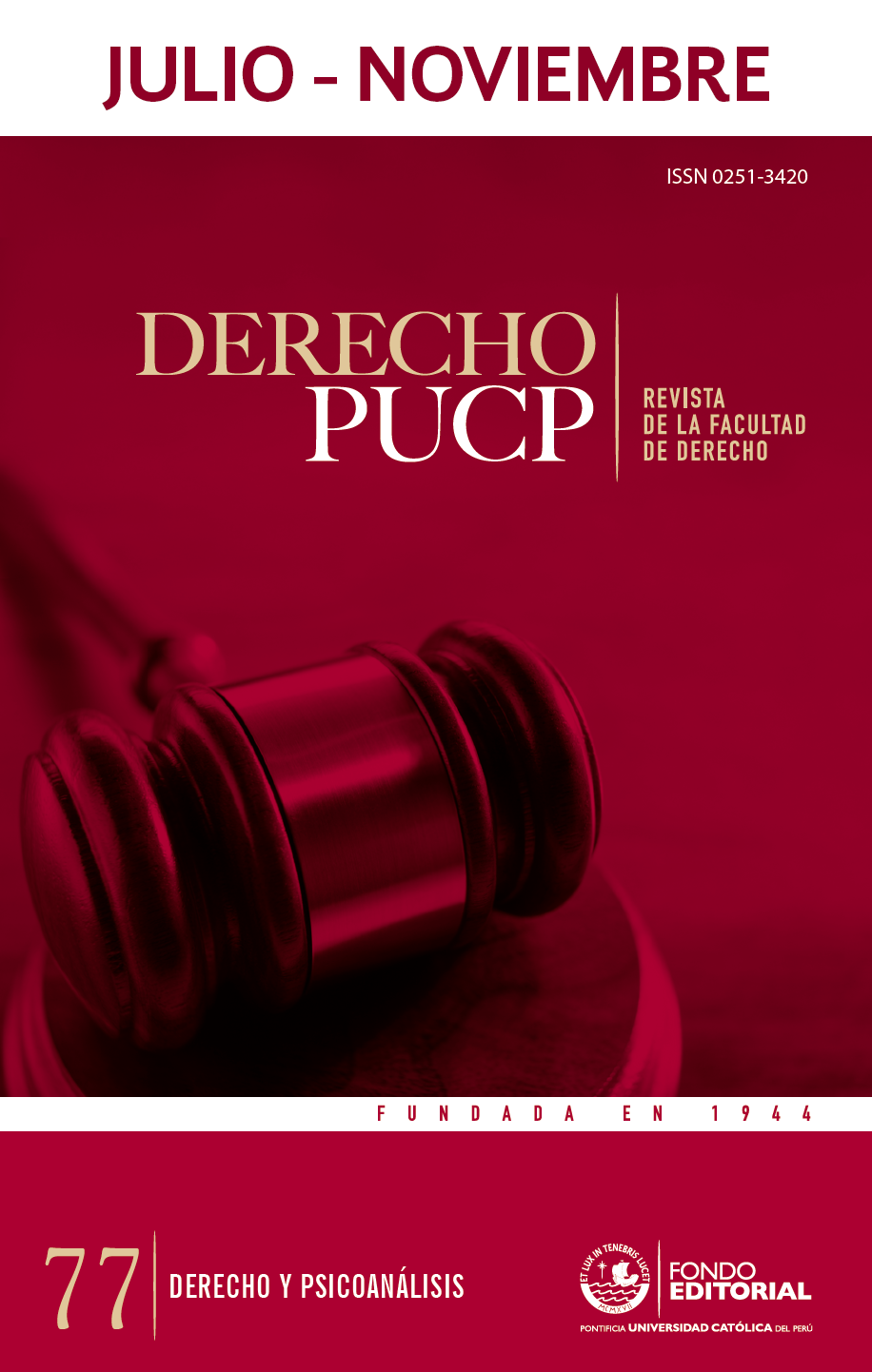Los usos del psicoanálisis en el derecho: la fuerza del ejemplo de Jay Katz
DOI:
https://doi.org/10.18800/derechopucp.201602.001Palabras clave:
derecho y psicoanálisis, Jay Katz, Joseph Goldstein, derecho de familia, tenencia de hijos, relación médico-paciente, consentimiento informadoResumen
El presente artículo muestras los posibles usos del psicoanálisis en el derecho a partir del trabajo académico de Joseph Goldstein y Jay Katz. Ambos parten de reconocer la importancia del psicoanálisis para prestar una atención seria y valiente a las dimensiones no racionales del ser humano, de las que debemos ser conscientes en el mundo del derecho. Partiendo de dicha premisa, el autor explora dos posibles usos del psicoanálisis en el derecho. Uno, representado por Goldstein, se centra en utilizar «premisas psicoanalíticas para resolver conflictos jurídicos», como, por ejemplo, al aportar información psicoanalítica para determinar el interés superior del niño en casos de tenencia. Mientras tanto, el otro, representado por Katz, busca «concientizar acerca de un conflicto en casos donde los todos actores se habían dedicado a reforzar mutuamente su fantasía de que no existía conflicto alguno» entre sujetos de una relación, como ocurría en la relación médico-paciente, con la finalidad de repensar estándares que habían sido fijados por el derecho bajo una ilusión de objetividad y racionalidad. El artículo explora estas dos aproximaciones a través de ejemplos, vinculándolas a dos perspectivas adoptadas por Freud a lo largo de su trabajo académico y tomando una postura preferente por la mirada de Katz.
Descargas
Citas
Burt, Robert A. (1979). Taking care of strangers: the rule of law in doctor-patient relations. Nueva York: The Free Press.
Burt, Robert A. (1992). The constitution in conflict. New Haven: Yale University Press.
Burt, Robert A. (2002). Death is that man taking names: intersections of American medicine, law, and culture. Berkeley: University of California Press.
Burt, Robert A. (2006). The uses of psychoanalysis in Law: the force of Jay Katz’s example. Yale Journal of Health Policy, Law and Ethics, 6(2), 401-413.
Freud, Sigmund (1930). Civilization and its discontents. En The Standard Edition of the Complete Psychological Works of Sigmund Freud. Volume 21 (1927-1931): The Future of an Illusion, Civilization and its Discontents and Other Works (pp. 64-145). Edición de James Strachey, Londres: Hogarth Press, 1961.
Freud, Sigmund ([1932] 1933). New introductory lectures on psycho-analysis. En The Standard Edition of the Complete Psychological Works of Sigmund Freud. Volume 22 (1932-1936): New Introductory Lectures on Psycho-Analysis and Other Works (pp. 7-182). Edición de James Strachey, Londres: Hogarth Press, 1964.
Freud, Sigmund (1937). Analysis terminable and interminable. En The Standard Edition of the Complete Psychological Works of Sigmund Freud. Volume 23 (1937-1939): Moses and Monotheism, An Outline of Psycho-Analysis and Other Works (pp. 209-253). Edición de James Strachey, Londres: Hogarth Press, 1964.
Goldstein, Joseph (1968). Psychoanalysis and jurisprudence. The Yale Law Journal, 77(6), 1053-1077. https://doi.org/10.2307/794884.
Goldstein, Joseph & Jay Katz (1965). The family and the law. Nueva York: The Free Press.
Goldstein, Joseph, Anna Freud & Albert Solnit (1973). Beyond the best interests of the child. Nueva York: The Free Press.
Goldstein, Joseph, Anna Freud & Albert Solnit (1979). Before the best interests of the child. Nueva York: The Free Press.
Goldstein, Joseph & otros (1986). The best interests of the child: the least detrimental alternative. Nueva York: The Free Press.
Katz, Jay (1969). The right to treatment – an enchanting legal fiction? University of Chicago Law Review, 36(4), 755-783. https://doi.org/10.2307/1598974.
Katz, Jay ([1984] 2002). The silent world of doctor and patient. Baltimore: Johns Hopkins University Press.
Loewald, Hans (1975). Psychoanalysis as an art and the fantasy character of the psychoanalytic situation. En Hans Loewald, Papers on psychoanalysis (pp. 352-371). New Haven: Yale University Press, 1980.
Normativa y Jurisprudencia
Corte Suprema de Iowa (1966). Painter v. Bannister. North Western Reporter, Second Series, 140, 152-158.
Descargas
Publicado
Cómo citar
Número
Sección
Licencia
Derechos de autor 2016 Derecho PUCP

Esta obra está bajo una licencia internacional Creative Commons Atribución 4.0.




